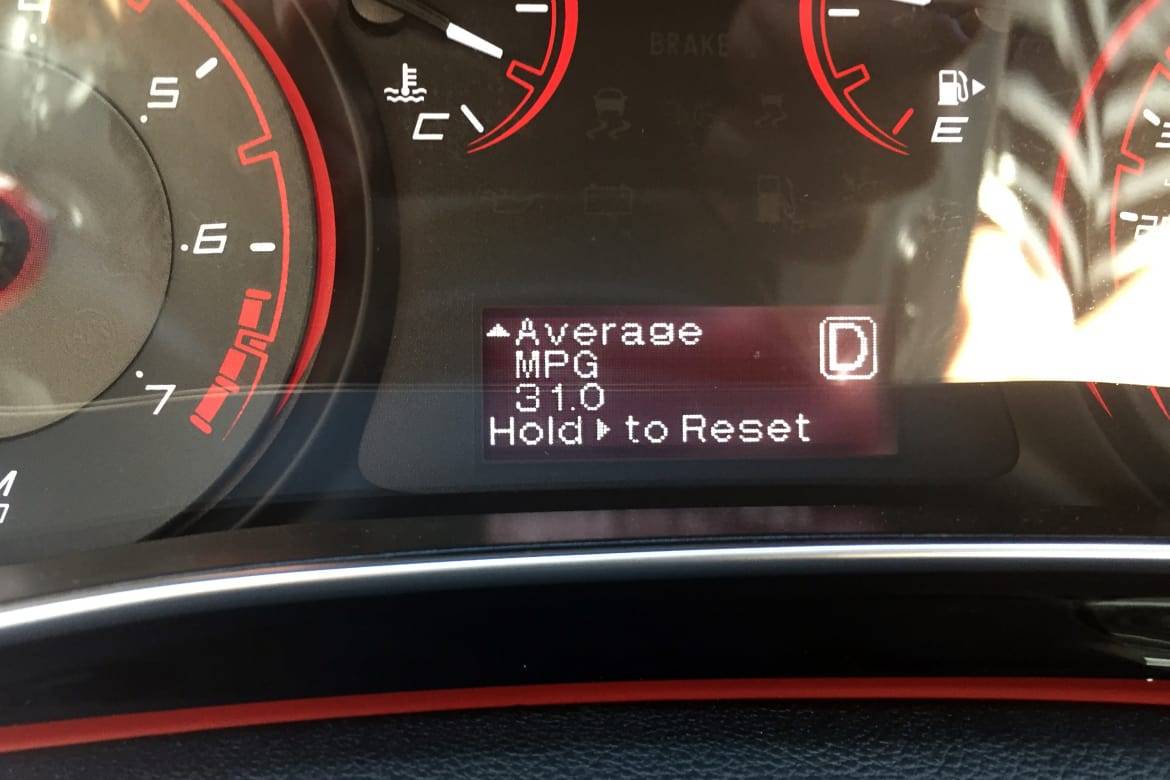2015 Dodge Dart SXT Real-World Fuel Economy


The 2015 Dodge Dart’s surprisingly powerful 2.4-liter engine is standard in three of the compact sedan’s five trim levels: SXT, GT and Limited. The 184-horsepower four-cylinder gives the Dart punchy acceleration and a performance edge over the hamster on a wheel used to power other compact cars, though the Dart’s power doesn’t come free.
Related: 2015 Dodge Dart expert review
The onboard trip computer of a 2015 Dodge Dart SXT I drove mostly at highway speeds registered 31 mpg during a determined Saturday afternoon road trip to watch some form of racing. What started out as a failed attempt to see at an autocross event in Milwaukee ended successfully at Great Lakes Dragaway in Union Grove, Wis. The round trip from Chicago’s north side resulted in a 184.7-mile trip.
EPA fuel economy ratings of the Dart with the six-speed automatic transmission are 23/35/27 mpg city/highway/combined in both SXT and Limited trims, while the GT trim is rated 22/31/26 mpg. My test Dart’s average speed of 36.7 mph included a mix of city traffic thrown into the mainly highway cruising. A mindful, light throttle was required to reach the Dart’s 35 mpg highway rating out on the open road; some cars like our long-term 2015 Honda Fit don’t take as much effort to hit their EPA ratings.
Here’s the thing, you don’t have a lot of options for a more efficient engine in the Dart, and 27 mpg combined is on the low end of the compact segment. The entry-level 160-hp, 2.0-liter four-cylinder in the Dart SE gets the same 27 mpg combined rating with an automatic transmission as the more powerful 2.4-liter, and the most efficient 160-hp, turbocharged 1.4-liter is available only in the Aero trim starting with model-year 2014. Aeros are rated at 28/40/32 mpg with the automatic transmission but require premium fuel for optimum fuel economy and performance.
The 27 mpg combined rating for the 2.0-liter and 2.4-liter engines that make up most of the Dart lineup leaves a lot of room for improvement. The Honda Civic, Ford Focus, Mazda3 and Kia Forte are all in the 31-34 mpg combined range with automatic transmissions and engines that don’t cost extra like the Dart’s 1.4-liter.
Not all is lost, however. While the 2016 model year won’t introduce any significant changes to the Dart lineup, Dodge’s five-year plan announced in early 2014 mentions the Dart is scheduled for a midcycle refresh in the middle of calendar year 2016 to “update style and design, enhance driving dynamics, align powertrain to brand DNA and leverage positioning between compact and midsize cars.” A Fiat Chrysler Automobiles spokesman was unable to comment if that timeline still stands, but hopefully the Dart’s next refresh means more fuel-efficient powertrains with a wider availability.

Managing Editor Joe Bruzek’s 22 years of automotive experience doesn’t count the lifelong obsession that started as a kid admiring his dad’s 1964 Chevrolet Corvette — and continues to this day. Joe’s been an automotive journalist with Cars.com for 16 years, writing shopper-focused car reviews, news and research content. As Managing Editor, one of his favorite areas of focus is helping shoppers understand electric cars and how to determine whether going electric is right for them. In his free time, Joe maintains a love-hate relationship with his 1998 Pontiac Firebird Trans Am that he wishes would fix itself. LinkedIn: https://www.linkedin.com/in/joe-bruzek-2699b41b/
Featured stories




